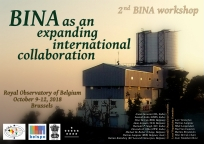Speaker
Mr
Amit Kumar Mandal
(Indian Institute of Astrophysics, CHRIST(Deemed to be University), Bangalore)
Description
Active galactic nuclei (AGN) are high luminosity sources powered by accretion of matter onto super-massive black holes (SMBHs). According to the unification model of AGN, the SMBH is surrounded by a dusty torus. It is difficult to study the extent of the dusty torus as the central region of AGN is not resolvable using any conventional imaging techniques available today. Though the current optical/infrared interferometric technique could in principle resolve the torus in nearby AGN, it is very expensive. An alternative and cheap method to the interferometric technique to find the extent of the dusty torus is through the technique of reverberation mapping. Towards this we are carrying out a dedicated monitoring program since the year 2016 using the 2-m Himalayan Chandra Telescope (HCT) operated by the Indian Institute of Astrophysics (IIA) in Bangalore (India). Our sample for this program consists of about a dozen sources suitable for observations using the HCT. Observations are routinely carried out once every 5 days to monitor our sample. We have obtained good estimates of the size of the torus in two AGN in our sample. This talk will outline the importance of this program, the observational strategy that is followed, the adopted analysis procedures, the results obtained till now from this program and the scope for Indo-Belgian collaboration.
Primary author
Mr
Amit Kumar Mandal
(Indian Institute of Astrophysics, CHRIST(Deemed to be University), Bangalore)
Co-authors
Dr
Blesson Mathew
(CHRIST(Deemed to be University))
Prof.
Ram Sagar
(Indian Institute of Astrophysics, Bangalore, 560034)
Dr
Stalin Chelliah Subramonian
(Indian Institute of Astrophysics, Bangalore)
Dr
Suvendu Rakshit
(Seoul National University)

